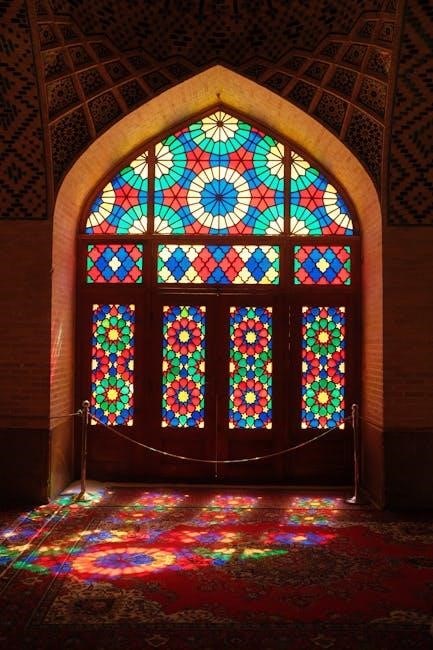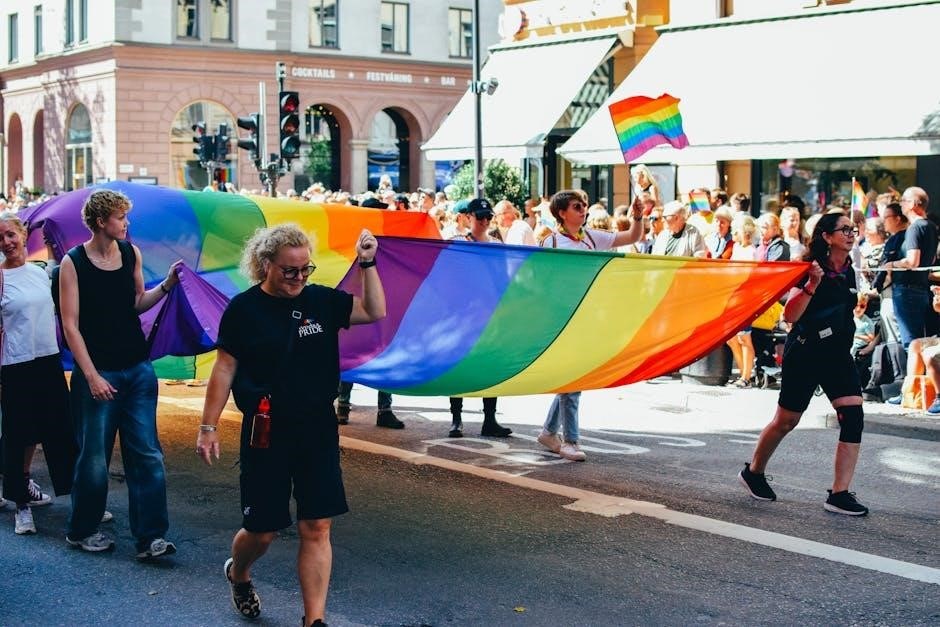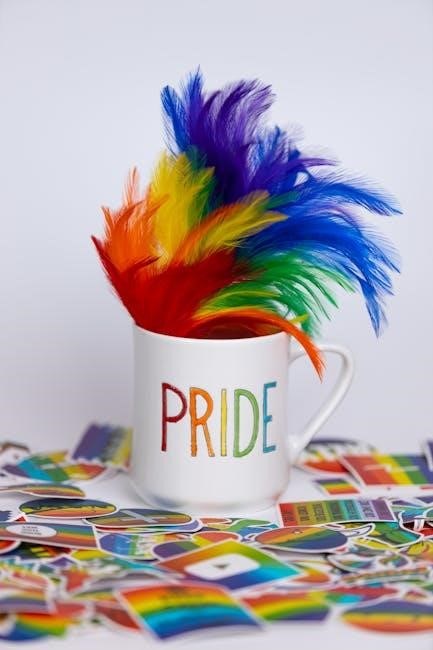This landmark choreopoem by Ntozake Shange debuted in 1976, blending poetry, music, and dance to explore the struggles and resilience of Black women, resonating deeply with audiences worldwide.
1.1 Overview of the Play
For Colored Girls Who Have Considered Suicide / When the Rainbow is Enuf, a groundbreaking choreopoem by Ntozake Shange, premiered in 1976. It weaves together poetry, music, and dance to depict the interconnected lives of seven Black women, exploring themes of identity, race, and resilience. The play’s innovative structure and raw emotional power have made it a landmark in American theatre, earning critical acclaim and inspiring audiences globally.
1.2 Importance of the Choreopoem Genre
Ntozake Shange’s For Colored Girls revolutionized theatre by pioneering the choreopoem genre, blending poetry, music, and dance. This innovative form gave voice to Black women’s experiences, breaking traditional norms and creating a powerful platform for marginalized stories. Its success underscored the genre’s ability to address societal issues through artistic expression, influencing both literature and social movements, and cementing its cultural significance;
Background of the Playwright, Ntozake Shange
Ntozake Shange, born in 1948, was a renowned poet, playwright, and feminist. Her work addressed race, gender, and identity, earning her acclaim and shaping modern theatre.
2.1 Early Life and Career
Born Paulette Williams in 1948, Ntozake Shange adopted her Zulu name meaning “she who comes with her own things.” She grew up in a culturally rich family, studying at Barnard and UCLA. Her early career as a poet and educator laid the groundwork for her groundbreaking choreopoem, blending personal and collective experiences of Black women, which debuted in 1976 and earned her an Obie Award;
2.2 Major Works and Contributions
Ntozake Shange’s most renowned work is the Obie Award-winning choreopoem, For Colored Girls Who Have Considered Suicide / When the Rainbow is Enuf. This groundbreaking piece seamlessly blends poetry, music, and dance, offering a powerful exploration of Black women’s experiences. Her work has significantly influenced feminist and civil rights movements, providing a voice to marginalized communities and reshaping contemporary theater with its innovative style and emotional depth.

Historical Context and Reception
For Colored Girls Who Have Considered Suicide / When the Rainbow is Enuf premiered in 1976, becoming a landmark work that shed light on Black women’s experiences, blending poetry and theater to address race, gender, and identity with raw honesty, resonating deeply with audiences and sparking critical acclaim.

3.1 Premiere and Initial Response
For Colored Girls Who Have Considered Suicide / When the Rainbow is Enuf premiered in 1976, blending poetry, music, and dance into a groundbreaking choreopoem. Its raw portrayal of Black women’s struggles resonated deeply, earning critical acclaim and an Obie Award. Audiences were moved by its honest exploration of identity, race, and gender, making it a pivotal moment in American theater history.

3.2 Cultural and Social Impact
Ntozake Shange’s choreopoem became a cultural phenomenon, empowering Black women by giving voice to their struggles and resilience. It challenged societal norms, fostering dialogue on race, gender, and identity; The play inspired countless adaptations and sparked conversations within feminist and civil rights movements, leaving a lasting legacy in both theater and social justice, continuing to resonate with marginalized communities today.
Structure and Style of the Play
The play is a choreopoem, blending poetry, music, and dance. It features seven women, each represented by a color, sharing their experiences through lyrical and symbolic expressions.
4.1 The Concept of a Choreopoem
A choreopoem is a revolutionary art form blending poetry, music, and dance. Introduced by Ntozake Shange, it creates a dynamic, multisensory experience. Each element—poetry, movement, and sound—interacts to convey themes and emotions. In For Colored Girls, this fusion allows the voices of seven women to resonate deeply, breaking cultural silences and celebrating resilience through a unified yet diverse expression of Black womanhood and survival.
4.2 Use of Poetry, Music, and Dance
Poetry, music, and dance intertwine to create a powerful narrative in For Colored Girls. Poetry expresses raw emotions, while music and dance amplify these feelings, transcending words. Each art form complements the others, creating a layered, immersive experience. This fusion allows the women’s stories to resonate deeply, blending personal struggles with collective strength, and celebrating resilience through a harmonious blend of artistic expression.
Themes and Symbolism
The play explores themes of identity, race, and gender, using the rainbow as a symbol of hope and survival, reflecting Black women’s resilience and collective strength.
5.1 Identity, Race, and Gender
For Colored Girls explores the intersections of identity, race, and gender, giving voice to Black women’s struggles and triumphs. Through poetic narratives, the play addresses systemic oppression, personal identity, and the resilience of Black women, emphasizing their shared experiences and collective strength. The choreopoem’s vivid imagery and emotional depth highlight the complexities of being a Black woman in a society fraught with racism and sexism, fostering a powerful message of survival and sisterhood.

5.2 Resilience and Survival
The play vividly portrays Black women’s resilience, transcending pain through collective strength. Each character’s story, expressed through poetry and dance, highlights survival as a triumph. Shange’s narrative weaves personal and communal struggles, celebrating endurance and the bonds of sisterhood. The choreopoem underscores the transformative power of resilience, offering hope and validation to those navigating systemic oppression and personal adversity.
Key Characters and Their Stories
The play features seven women, each representing a color of the rainbow, sharing personal tales of struggle, love, and empowerment, collectively weaving a powerful narrative of survival and unity.

6.1 The Seven Women and Their Experiences
The seven women, each representing a color of the rainbow, share deeply personal stories of identity, trauma, and resilience. Through their narratives, they explore themes of race, gender, and survival, creating a collective tapestry of Black women’s lives. Their experiences, though individual, intersect to form a powerful testament to strength and unity in the face of adversity, resonating deeply with audiences.
6.2 Representation of Black Women’s Voices
For Colored Girls amplifies the voices of Black women, offering a platform to express their struggles, joys, and resilience. Through poetic monologues, the play challenges stereotypes and celebrates their identities, fostering empathy and understanding. It became a cultural touchstone, validating Black women’s experiences and inspiring future generations to embrace their authenticity and strength in the face of systemic oppression and societal challenges.
Stage Adaptations and Productions
The play has seen numerous stage adaptations, including a 2019 Off-Broadway production and an Indian adaptation, When the Rainbow is Enough, highlighting its enduring relevance and universal appeal.
7.1 Off-Broadway and Broadway Productions
The 2019 Off-Broadway production of For Colored Girls captivated audiences with its powerful blend of poetry, music, and dance. Directed by noted artists, it showcased the resilience and struggles of Black women, resonating deeply. The play’s universal themes also inspired an Indian adaptation, When the Rainbow is Enough, further highlighting its global impact and enduring relevance in contemporary theatre.
7.2 Notable Directors and Performances
Director Larry L. Life and Costume Designer Leslie Carmin-Hammer brought vibrant interpretations to the play. The 2019 Off-Broadway production, filled with passion and honesty, highlighted the transformative power of Ntozake Shange’s work. Performances showcased the fusion of poetry, music, and dance, emphasizing the resilience and struggles of Black women, leaving a lasting impact on both audiences and critics alike.
Availability of the Script in PDF Format
The script is available in PDF and ePUB formats from digital publishers and online archives. Sources include the Internet Archive and academic platforms, ensuring accessibility for readers worldwide.
8.1 Sources for Downloading the Script
The script of For Colored Girls Who Have Considered Suicide / When the Rainbow is Enuf can be downloaded from the Internet Archive, academic platforms like Indiana University’s digital library, and other reputable sources. Ensure legality by accessing through authorized publishers or educational institutions offering ePUB or PDF formats for scholarly purposes.
8.2 Legal and Ethical Considerations
Downloading For Colored Girls Who Have Considered Suicide / When the Rainbow is Enuf in PDF requires respecting copyright laws. Accessing the script through unauthorized platforms is illegal and unethical. Always obtain the text from legitimate sources, such as licensed publishers or academic databases, to support the creator and comply with intellectual property rights. Ethical access ensures fair compensation for the author’s work.
Critical Analysis and Reviews
Critics and scholars acclaim For Colored Girls for its profound impact, blending poetry and performance to address race, gender, and identity with unflinching honesty and cultural significance.
9.1 Academic and Literary Criticism
Scholars praise For Colored Girls as a groundbreaking work, blending poetry, music, and dance to address race, gender, and identity. Academic critiques highlight its emotional authenticity, innovative structure, and resonance with Black women’s experiences, while literary analyses explore its themes of resilience and survival, solidifying its status as a transformative piece in contemporary theatre and feminist literature.
9.2 Audience Reception and Testimonials
Audiences have praised For Colored Girls for its raw honesty and emotional depth, describing it as life-changing and empowering. Many testify to its ability to resonate deeply, particularly with Black women, validating their experiences and fostering a sense of community. The play’s transformative power continues to inspire new generations, solidifying its impact as a cultural and emotional touchstone.
Cultural Significance and Legacy
Ntozake Shange’s groundbreaking choreopoem revolutionized theater, giving voice to Black women’s experiences and inspiring future generations. Its blend of art forms and unflinching honesty left an indelible mark on culture.
10.1 Influence on Contemporary Theatre
Ntozake Shange’s For Colored Girls redefined modern theater by merging poetry, music, and dance into a powerful narrative. Its innovative choreopoem style has inspired countless playwrights, fostering a new wave of interdisciplinary storytelling. The play’s unflinching portrayal of Black women’s experiences continues to influence contemporary productions, encouraging bold, inclusive, and emotionally resonant works that challenge societal norms and amplify marginalized voices.

10.2 Adaptations and Interpretations
Ntozake Shange’s choreopoem has been reimagined in various productions, including Off-Broadway revivals and international adaptations. Its universal themes have inspired reinterpretations, such as the Indian adaptation When the Rainbow is Enough, showcasing its global resonance. The play’s availability in PDF and ePUB formats has further expanded its reach, allowing new generations to engage with its powerful narrative and emotional depth.
Educational Resources and Study Guides
Educators and students can access detailed study guides and analyses of the play, enhancing understanding of its themes and structure. PDF scripts and scholarly articles provide valuable insights.
11.1 Analysis for Students and Scholars
For Colored Girls Who Have Considered Suicide / When the Rainbow is Enuf is a choreopoem exploring themes of identity, race, and resilience. PDF scripts and study guides offer in-depth analyses of its poetic structure, character development, and cultural significance. Scholars can examine the blending of poetry, music, and dance, while students gain insights into the play’s historical context and its impact on contemporary theatre.
11.2 Teaching the Play in Classrooms
Teaching For Colored Girls involves using PDF scripts for interactive learning. Educators can incorporate discussions, performances, and reflective writing to engage students. The choreopoem’s themes of identity and resilience resonate deeply, encouraging critical thinking and empathy. Classroom activities can also explore the blending of art forms, fostering a holistic understanding of the play’s cultural and historical significance.
Comparisons with Other Works
Ntozake Shange’s work is often compared to other feminist and civil rights plays, yet its unique blend of poetry, music, and dance sets it apart, offering profound emotional depth.
12.1 Similar Themes in Other Plays
Plays like Lorraine Hansberry’s A Raisin in the Sun and Anna Deavere Smith’s performance pieces explore similar themes of racial identity, gender struggles, and personal resilience. These works, while differing in style, share a common goal of amplifying marginalized voices and challenging societal norms, resonating emotionally with audiences seeking authentic representations of diverse experiences and struggles;

12.2 Shange’s Unique Contribution
Ntozake Shange’s innovative use of the choreopoem genre in For Colored Girls revolutionized theatre by blending poetry, music, and dance. Her unflinching portrayal of Black women’s struggles and resilience provided a groundbreaking voice to marginalized experiences. Shange’s work remains a landmark, earning her an Obie Award and cementing her legacy as a pioneer in amplifying diverse narratives in American theatre.
Modern Relevance and Revivals
For Colored Girls remains a powerful, timeless work, with recent productions in 2019 and 2022, continuing to resonate as a choreopoem addressing race, gender, and resilience.

13.1 Recent Productions and Revivals
Recent productions, such as the 2019 Off-Broadway revival and a 2022 staging, highlight the enduring impact of Shange’s work. These revivals demonstrate the choreopoem’s continued relevance, blending poetry, music, and dance to address contemporary issues. The play’s powerful exploration of identity and resilience ensures its message remains vital today.
13.2 Continued Resonance in Today’s Society
Shange’s work remains a powerful voice for marginalized communities, addressing themes like race, gender, and identity. Its exploration of resilience and survival continues to inspire, making it a cornerstone of contemporary theatre and social discourse, ensuring its relevance in today’s society.
The Play’s Influence on Social Movements
Shange’s work has significantly impacted feminist and civil rights movements, empowering marginalized communities and amplifying Black women’s voices, fostering social change and cultural awareness.
14.1 Connection to Feminist and Civil Rights Movements
Ntozake Shange’s choreopoem became a pivotal voice in both feminist and civil rights movements, addressing intersectional oppression faced by Black women. Its raw portrayal of race, gender, and identity resonated deeply, inspiring activism and fostering dialogue. The play’s themes of resilience and survival aligned with the broader struggles of these movements, making it a cornerstone of cultural and political expression during its time.
14.2 Empowerment of Marginalized Communities
For Colored Girls empowered marginalized communities by amplifying the voices of Black women, addressing their unique struggles, and celebrating their resilience. The play’s unflinching portrayal of race, gender, and identity provided validation and strength to those often silenced. Its global impact, including adaptations like India’s When the Rainbow Is Enough, further underscored its ability to inspire and uplift diverse audiences, fostering unity and solidarity worldwide.

For Colored Girls remains a powerful testament to the resilience and strength of Black women, offering timeless insights into identity, race, and survival, ensuring its enduring relevance and impact.
15.1 Summary of Key Points
Ntozake Shange’s For Colored Girls is a groundbreaking choreopoem addressing Black women’s struggles, blending poetry, music, and dance. Its exploration of identity, race, and resilience resonated deeply, earning critical acclaim and inspiring adaptations. The play’s script is widely available in PDF format, with sources like academic archives and digital libraries offering legal access, ensuring its enduring impact on contemporary theatre and social discourse.
15.2 Final Reflections on the Play’s Significance
For Colored Girls remains a profound exploration of Black women’s experiences, offering a powerful voice to marginalized stories. Its innovative blend of art forms and unflinching honesty has made it a cultural icon, inspiring both social change and artistic evolution. The play’s enduring relevance continues to resonate, ensuring its legacy as a cornerstone of contemporary theatre and a testament to resilience and empowerment.
